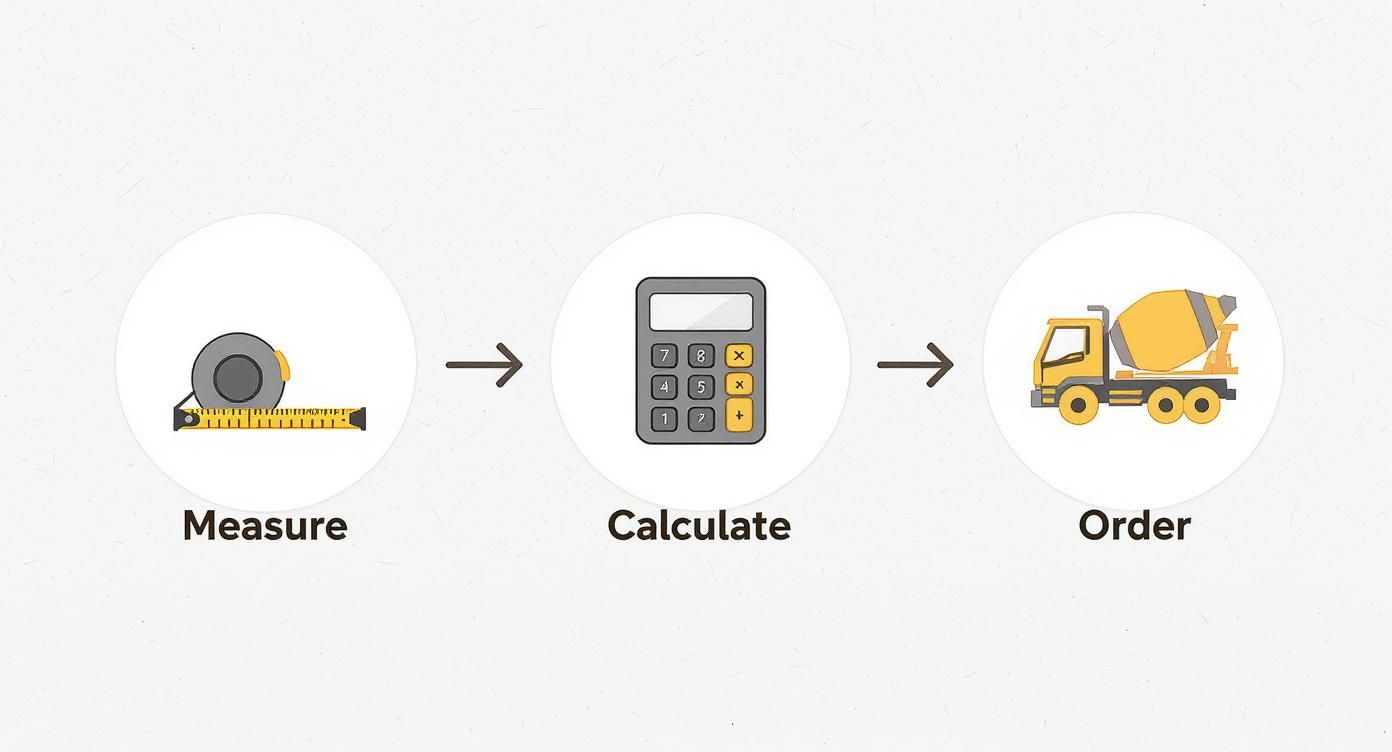calculating concrete volume: quick, accurate steps
calculating concrete volume: quick, accurate steps
Calculating the right amount of concrete is one of those things that can make or break a project. Get it right, and you're off to a smooth start. Get it wrong, and you’re looking at a costly headache. The basic formula is simple enough—Length x Width x Depth—but truly mastering it will save you from ordering too much material or, even worse, running out mid-pour.
Why Accurate Concrete Calculations Matter
Nailing your concrete estimate is the foundation of any successful job, quite literally. A rough guess can quickly spiral into serious money and logistical issues, turning a straightforward task into a complete mess. The consequences are real, and they can throw your timeline and budget way off course.
Ordering too much might feel like playing it safe, but it's just plain wasteful. You're not only paying for concrete you can't use, but you also have to figure out how to get rid of it, which comes with its own costs and environmental impact. Our guide on waste disposal in construction dives into how good planning can keep this problem to a minimum.
On the flip side, under-ordering is a project manager's nightmare. It causes delays and can create weak points in the structure where the new and old concrete meet.
A mid-pour shortage is more than just an inconvenience; it can compromise the structural integrity of your entire project by creating a 'cold joint'—a notorious weak spot in concrete slabs and foundations.
Navigating Market Instability
With material costs and availability all over the place, precise calculations are more critical than ever. The UK construction sector has seen a major drop in domestic cement production recently. In fact, the UK produced only 7.3 million tonnes of cement not long ago, which is the lowest it’s been since 1950 and about half of what it was in 1990. This means we're relying more on volatile international markets, making accurate ordering a must to dodge supply chain chaos.
Understanding these bigger financial ripples is key. For larger-scale work, using a commercial construction cost calculator can give you a clearer picture of how your material estimates fit into the overall project budget. By getting a handle on a few basic principles, you can make sure your project starts on solid, stable ground.
Getting Your Project Measurements The Right Way
Everything hinges on one thing: getting your measurements right. You can have the best formula in the world, but if your initial numbers are off, you're setting yourself up for a headache. Whether you’re pouring a simple shed base or a more complex foundation, being precise from the get-go is non-negotiable.
First things first, grab a reliable tape measure and jot down the length, width, and depth of the area you're working on. For a straightforward square or rectangular slab, like a patio, this sounds easy enough. But a classic rookie mistake is only measuring once. I always recommend measuring the length and width in at least two different spots. It's a quick check that accounts for any slight variations in your formwork.
Dealing with Different Shapes and Depths
Let's be honest, most jobs aren't perfect rectangles. You’ll often run into shapes and challenges that need a bit more thought.
- Circular Columns: For things like fence posts or deck footings, you'll be measuring the radius (that's half the diameter) and how deep the hole is.
- Varying Depth: If you've got a slope for drainage, measure the depth at its shallowest point and again at its deepest. Add those two numbers together and divide by two to get your average depth. This is a critical step for an accurate volume.
- Irregular Shapes: Got a weird-shaped area? Don't panic. Just break it down into smaller, simpler rectangles and squares. Figure out the volume for each little section on its own, then just add them all up to get your grand total.
The golden rule here is to stick to one unit of measurement. If you measure the length in metres, make sure the width and depth are in metres too. Mixing units is a surefire way to end up with the wrong amount of concrete.
Ultimately, the whole process boils down to three key stages: measuring properly, calculating correctly, and ordering your materials with confidence.

As you can see, a successful project flows directly from precise measurements to correct calculations and finally to a well-placed order. It's a simple chain of events, but each link is as important as the last.
It's also interesting to see how demand for materials holds up over time. Historical data shows that deliveries of concrete blocks in Great Britain have been remarkably stable compared to bricks since the 1960s. Even as overall construction volumes have gone up and down, this highlights just how vital these core building materials are—and why getting your volume calculations spot on will always matter. You can dig into more of these construction material trends on the official UK government statistics page.
Getting to Grips with Concrete Volume Formulas
Right, you’ve got your project dimensions jotted down. Now it’s time to put those numbers to work. This is where a little bit of straightforward maths saves you a lot of hassle and helps you calculate your concrete volume accurately. Don’t worry, the formulas are simple, and we'll walk through them with some real-world examples.

The formula you'll probably use most often is for square or rectangular slabs – think shed bases, small patios, or pathways. It's the one most people remember from school, and it's the perfect starting point.
The formula is as simple as it gets: Length x Width x Depth = Volume
Let's imagine you’re pouring a base for a new garden shed. Your measurements are 4 metres long, 3 metres wide, and the slab needs to be 0.15 metres deep.
Your calculation would look just like this:
- 4m (Length) x 3m (Width) x 0.15m (Depth) = 1.8 cubic metres (m³)
And there you have it. That number is the exact volume of concrete you'll need to fill that space perfectly.
Calculating Volume for Circular Shapes
Of course, not every project is a neat rectangle. You'll often find yourself needing to calculate the volume of a cylinder, especially for jobs like setting deck posts, fence posts, or bollards. The formula is a bit different, but it’s just as easy once you know what’s what.
The formula for a cylinder is: π (Pi) x Radius² x Depth = Volume
Say you're digging a hole for a deck footing. The hole has a diameter of 0.5 metres and you need to fill it to a depth of 0.8 metres.
First things first: the radius is always half the diameter. So, for a 0.5m diameter, your radius is 0.25 metres. Pi (π) is a constant, which we'll round to 3.14. Now you’ve got everything you need.
Let's break down the calculation:
- 3.14 (π) x (0.25m x 0.25m) x 0.8m (Depth) = 0.05 cubic metres (m³) per footing
Once you've got these two core formulas down, you’re well-equipped to handle the vast majority of jobs that come your way, from large foundations to small repair tasks.
Getting Your Order Spot On: Unit Conversions and Waste
Okay, so you’ve got your volume calculation nailed down. That’s a huge step, but the job isn’t quite finished. This is actually where a lot of projects can hit a frustrating snag. The units you worked everything out in might not be the same units your supplier uses to sell concrete. It’s a simple mix-up, but it can lead to ordering completely the wrong amount, causing delays you just don’t need.
You might have done all your sums in cubic metres (m³), but it's not uncommon for suppliers to list their prices per cubic foot, or even by weight in kilograms. Keeping your conversions straight is absolutely essential.

If you're juggling different units, a handy online calculator like a Feet to Inches conversion tool can be a real lifesaver, ensuring your calculations stay accurate.
Don't Forget the Waste Factor
Beyond the maths of unit conversions, there’s a crucial real-world detail that can make or break your pour: waste. Let's be honest, no job is ever perfect. You're bound to lose a bit of concrete to spillage, slight over-excavation, or just the simple fact that the ground is never perfectly level. If you order the exact calculated amount, you're almost certainly going to come up short.
The industry standard is to add a 5% to 10% contingency, or 'waste factor', to your final volume. Think of this small buffer as your project's insurance policy against the nightmare of running out of concrete mid-pour.
Let’s say your initial calculation came out to 1.8 m³. A sensible waste factor would look something like this:
- For 5% extra: 1.8 x 1.05 = 1.89 m³
- For 10% extra: 1.8 x 1.10 = 1.98 m³
This tiny addition makes all the difference, ensuring you have enough material to get the job done right without any interruptions. Trust me, ordering a little extra from the start is far cheaper and less stressful than having to place a second, smaller order later on.
And what about the leftovers? Any small amount of excess can often be put to good use on-site. It's also worth understanding the principles behind the recycling of aggregates, which helps you manage any leftover materials responsibly. As a final tip, always round up your order to the nearest convenient unit your supplier offers. This simple step is how you turn a precise calculation into a practical, successful order.
Common Mistakes When Ordering Concrete

Getting your calculations right is a massive step, but a few common slip-ups can still happen between your notepad and placing the order. Knowing what these pitfalls are is the key to a smooth project, helping you avoid the kind of costly delays that can bring your work to a screeching halt.
One of the most frequent errors I see is people forgetting to account for things already in the pour. If your slab includes rebar or mesh for reinforcement, those materials take up space. It might not seem like much, but on larger projects, the volume displaced by steel can be significant, leaving you with more concrete than you know what to do with.
Another classic mistake is misjudging the depth of an uneven excavation. Don't just measure one spot and call it a day—that's a recipe for disaster. Always take multiple depth measurements across the entire area and work out an average. It’s the only way to get a true picture of the volume you really need.
Forgetting About Site Access and Waste
It's not just about the numbers; practical logistics play a huge part. Before you even pick up the phone, think about how the delivery lorry is going to access your site. Are there overhead cables? Tight corners to navigate? This all affects the pour.
In the same way, you need a plan for waste. While ordering a little extra is smart, you also need a plan for any leftover material and the general construction debris that comes with any job. Thinking ahead about what size skip you need will save you from a last-minute scramble.
A clear conversation with your supplier is your best defence. Don't just order a volume; explain the project (e.g., "it's for a shed base"). This allows them to check that the mix strength and consistency are right for the job.
This kind of forward-thinking is especially important right now. Recent reports show that UK concrete market volumes have hit historic lows, with ready-mixed concrete sales falling by 11.5% in a recent quarter to their lowest annual level since 1963. These market conditions mean suppliers have less flexibility, making accurate calculations and clear communication more vital than ever. You can read more about these construction market trends and their impact.
Got Questions About Your Concrete Calculations?
Even when you've got the formulas down, a few questions always seem to pop up on the job. Let's run through some of the most common ones I hear, just to clear up any last-minute doubts before you order your concrete.
How Much Concrete Do I Need for Fence Posts?
This is a classic. The truth is, it depends entirely on your post size and how big you've dug the hole.
For a standard 4×4 post sitting in a hole that's about 10-12 inches wide and 24-30 inches deep, you’ll typically need 1-2 bags of 60 lb concrete. If you're working with chunkier 6×6 posts, you're probably looking at 3-4 bags per hole.
A crucial tip: always make sure your hole is deeper than the local frost line. This stops the post from being pushed upwards by frozen ground during a cold snap.
Should I Bother Subtracting the Volume of Rebar?
For most domestic jobs – think shed bases, patios, or a new garden path – the amount of space taken up by rebar is so small it’s not worth worrying about.
In fact, the standard 5-10% extra you add for waste will more than make up for the volume of the steel. It's only on huge commercial foundations with dense networks of reinforcement that engineers will sit down and calculate the precise displacement of the steel.
For the average DIY project, the simple answer is no. Just focus on getting your initial measurements right, add a bit extra for contingency, and you'll have plenty of material to get the job done.
What if My Project Has Sloping or Uneven Depths?
It’s a rare sight to see a perfectly level excavation on the first go. If your project has a deliberate slope for drainage or is just on uneven ground, don't fall into the trap of guessing an average depth.
The proper way to handle this is to take depth measurements at several different points. At a minimum, measure the shallowest and deepest parts. Then, add all your measurements together and divide by the number of spots you measured. This simple bit of maths gives you a much more reliable average depth, leading to a far more accurate final calculation.
Ready to manage the waste from your next concrete project? The Waste Group offers reliable skip hire and waste management solutions to keep your site clean and compliant. Get a quote online today.



